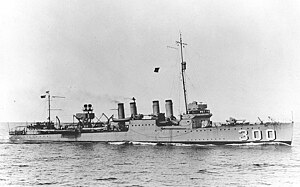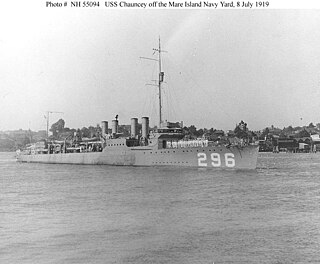
USS Chauncey (DD-296) was a Clemson-class destroyer (ship) built for the United States Navy during World War I.

USS McCawley (DD-276) was a Clemson-class destroyer built for the United States Navy during World War I. She was armed with 4 × 4 inch and 2 × 1 pounder guns. She was commissioned on 22 September 1919, served with the Pacific Fleet for 3 years and was laid up on 7 June 1922. McCawley was recommissioned on 27 September 1923, again serving in the Pacific, and decommissioned in 1930 before being sold for scrap.

USS Meyer (DD-279) was a Clemson-class destroyer built for the United States Navy during World War I.

USS Doyen (DD-280) was a Clemson-class destroyer built for the United States Navy during World War I.

USS Fuller (DD-297) was a Clemson-class destroyer built for the United States Navy during World War I.

USS Percival (DD-298) was a Clemson-class destroyer built for the United States Navy during World War I.

USS John Francis Burns (DD-299) was a Clemson-class destroyer built for the United States Navy during World War I.
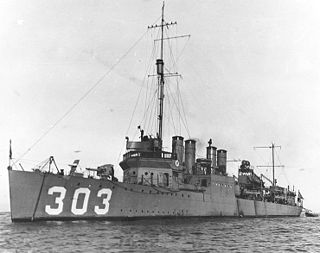
USS Reno (DD-303) was a Clemson-class destroyer built for the United States Navy during World War I.

USS Farquhar (DD-304) was a Clemson-class destroyer built for the United States Navy during World War I.

USS Kennedy (DD-306) was a Clemson-class destroyer built for the United States Navy during World War I.
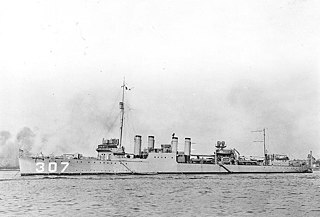
USS Paul Hamilton (DD-307) was a Clemson-class destroyer built for the United States Navy during World War I.

USS Zeilin (DD-313) was a Clemson-class destroyer in service with the United States Navy from 1920 to 1930. She was scrapped in 1930.

USS LaVallette (DD-315) was a Clemson-class destroyer in service with the United States Navy from 1920 to 1930. She was scrapped in 1931.

USS Kidder (DD-319) was a Clemson-class destroyer in service with the United States Navy from 1921 to 1930. She was scrapped in 1931.
USS Chase (DD-323) was a Clemson-class destroyer built for the United States Navy during World War I.

USS Mervine (DD-322) was a Clemson-class destroyer in service with the United States Navy from 1921 to 1930. She was scrapped in 1931.

USS Mullany (DD-325) was a Clemson-class destroyer built for the United States Navy during World War I.

USS Preston (DD-327) was a Clemson-class destroyer built for the United States Navy during World War I.
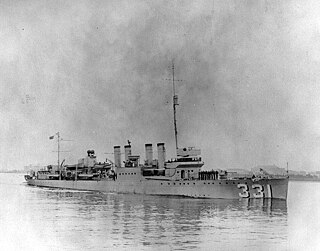
USS Macdonough (DD-331) was a Clemson-class destroyer built for the United States Navy during World War I.

USS Melvin (DD-335) was a Clemson-class destroyer in service with the United States Navy from 1921 to 1930. She was scrapped in 1931.
